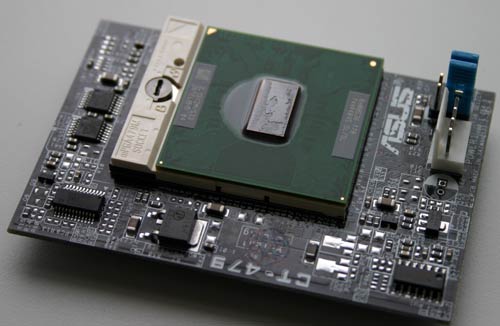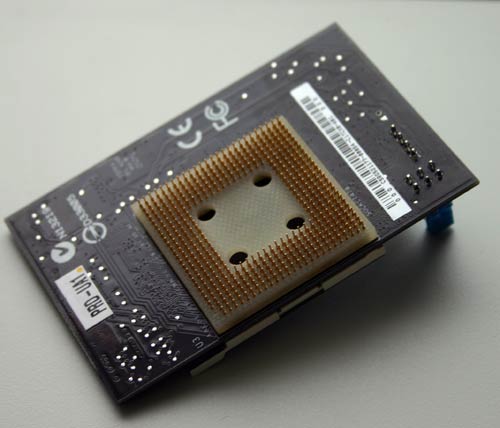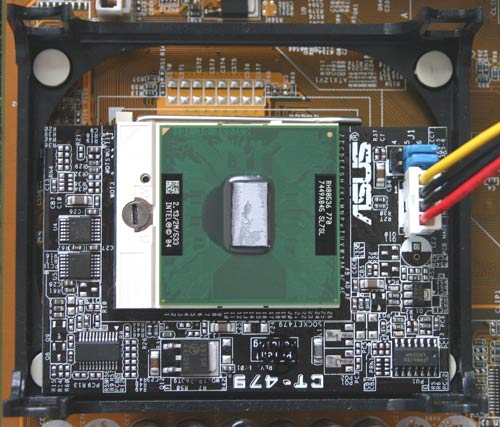Intel's Pentium M Desktop Part II: ASUS' Pentium M to Pentium 4 Socket Adapter
by Anand Lal Shimpi on March 24, 2005 1:31 PM EST- Posted in
- CPUs
ASUS CT-479: Socket-478 to Socket-479 Adapter
Enter the ASUS CT-479 CPU Upgrade Kit, an adapter board that will convert specific ASUS Socket-478 motherboards to support Pentium M CPUs. You will remember from our original Pentium M desktop article that the pinout of the Pentium M is different than the Pentium 4, although the two chips are electrically compatible (they use the same FSB). The next problem is that the Pentium M relies on a much lower voltage version of the Pentium 4's FSB, which is also addressed by ASUS' adapter, a problem that we did not think was solvable until now.
The CT-479 only works with ASUS motherboards, and only a limited number of them at that. Currently, only the ASUS P4P800-SE and P4P800-VM motherboards are supported, both of which are i865 based motherboards. ASUS is working on support for other boards; the P4C800-E (875P) will be supported soon. For our tests, we used a P4P800-SE; you need a BIOS update, but that's all. Obviously, non-ASUS motherboards are not supported; however, we're not certain whether or not the adapter can be made to work in other boards. We will be looking into this as time goes on, but we wanted to make sure that we could complete this article first before doing anything that would damage our setup.


The CT-479 supports all Pentium M and Celeron M CPUs (Dothan and Banias based) with the exception of the Low Voltage and Ultra Low Voltage versions.

The jumpers switch between 400 and 533MHz FSB settings. The power connector powers the adapter.
The CT-479 comes with the adapter board, heat sink/fan and power cable.

A perfect fit

The supplied heat sink is specifically made for the CT-479.
Currently, ASUS is listing the CT-479 as a part of a bundle with the P4P800-SE, priced at $130. At that price, the solution is almost half the price of the AOpen/DFI motherboards, and you get all of the benefits of the 865 chipset. The main benefit of the 865 chipset in this case is its dual channel DDR400 memory controller. The 533MHz FSB Pentium Ms are memory bandwidth starved by the 855GME's single channel DDR333 memory controller, so being paired with an 865 gives the CPU more memory bandwidth than it can use.
The P4P800-SE that we tested only allowed for 5:4 and 1:1 memory clock speed ratios, meaning that for our 533MHz FSB Pentium M, the maximum stock memory clock was DDR333. But since we're talking about a dual channel memory controller, even at DDR266 speeds, you have enough memory bandwidth for the processor - DDR400 support isn't necessary.
The other major benefit of the CT-479 is that you get to use a mature, mass-produced ASUS motherboard instead of a smaller production run, recently released 855GME solution. The benefits were clear in our testing - overclocking the Pentium M was far less of an ordeal on the ASUS solution.
The CT-479 does not support the Pentium M's SpeedStep technology, which has a handful of implications:
1) System power consumption will be higher on the ASUS solution than on 855GME based systems from AOpen/DFI. The reason being that the CPU will always run at maximum frequency, which is still lower power consumption than any other desktop processor, but it is worth mentioning.
2) You can't adjust the clock multiplier of the Pentium M like you can on the AOpen/DFI offerings. This will hamper the more adventurous overclockers, but it's definitely not a show stopper.
You also can't adjust the Pentium M's core voltage when using the CT-479; you're stuck at the default voltage. ASUS' Q-Fan technology (which allows for the automatic reduction of fan speed depending on thermal load) is supported, so you can reduce noise output even if SpeedStep isn't supported.
ASUS just announced the CT-479 last week, so there are some details that aren't yet available, such as whether or not the kit will be offered outside of the ASUS motherboard bundle. As soon as we have this information, we'll pass it along, but even if the only way to get it is with an ASUS motherboard, it is still a much better value than a standalone Pentium M motherboard.
The question here is how big of an impact does the 865 chipset have on the desktop performance of the Pentium M? To find out, we paired it with the Pentium M 770, Intel's fastest Pentium M running at 2.13GHz. The Pentium M 770 requires a 533MHz FSB, which is supported by the 865 chipset, and thus, is also supported by the CT-479 upgrade kit.
The Test
Our hardware configurations are similar to what we've used in previous comparisons.
AMD Athlon 64 Configuration
Socket-939 Athlon 64 CPUs
2 x 512MB OCZ PC3200 EL Dual Channel DIMMs 2-2-2-10
NVIDIA nForce4 Reference Motherboard
ATI Radeon X800 XT PCI Express
Intel Pentium 4 Configuration
LGA-775 Intel Pentium 4 and Extreme Edition CPUs
2 x 512MB Crucial DDR-II 533 Dual Channel DIMMs 3-3-3-12
Intel 925XE Motherboard
ATI Radeon X800 XT PCI Express
Intel Pentium M Configuration
Intel Pentium M 725 - 755
2 x 512MB OCZ PC3200 EL Dual Channel DIMMs 2-2-2-10
AOpen GMEm-LFS Motherboard
ASUS P4P800-SE + CT-479 Adapter
ATI Radeon X800 XT AGP










48 Comments
View All Comments
Avalon - Thursday, March 24, 2005 - link
In Soviet Russia, the Pentium-M owns you!In all seriousness, though...I was reading the benchmarks and wondering where the 855GME desktop P-M 770 benchmarks were. You only had the 770 on the Asus board. While this is all fine and dandy, it doesn't show us the full extent of the benefits of the Asus pin adapter over using an 855GME desktop board. While you could extra some data, I would have liked 770 desktop benches as a comparison. All in all, though, the Asus adapter is definitely nice due to the price alone.
Wonga - Thursday, March 24, 2005 - link
I don't think anyone can criticise Intel too harshly for releasing the Netburst architecture. Yes, Willamet stank, and Prescott isn't exactly an efficient core, but a Northwood processor was the best CPU money could buy for about 18 months before the K8 hit the scene. So, it doesn't really matter how Intel got there, but Netburst was the architecture to have for those 18 months.Anyway, Anand, I'd appreciate it if you could see if those adaptors would work on other S478 motherboards :)
Oh, and thanks for a great article! Perhaps that Pentium M horse that was beaten so much can now finally rest in peace!
sprockkets - Thursday, March 24, 2005 - link
While the boards and tech mentioned here are nice, why not also test some of the PM mini-itx boards at www.logicsupply.com and see how badly it can kick an Mac Mini's ass? OR, how well it can perform in such small space with little heat and noise output?xtknight - Thursday, March 24, 2005 - link
amazing it beats the fx-55 at q3 source compile. maybe i need to get my eyes checked but does that say INTEL?mkruer - Thursday, March 24, 2005 - link
Here is what I get out of this,1. P-M is better clock then the P4 and apparently the AMD64, (at least in some applications)
2. Future versions of the P-M while adding better FP and SSEx Instructions will still not have 64-bit technology.
3. Adding better FP and SSEx, will also increase the minimal thermal rating, resulting in a lower maximum over clocking ability, and higher heat dissipation
All and all, it looks to be about the same as AMD64, when all the upgrades are added in.
ncage - Thursday, March 24, 2005 - link
#5 It probably wouldn't be that good for intel to drop Pentium M prices. Yes there would get more sales from techies like us but that wouldn't increase there sales that much. Where they get sales would be from labtops and their profit margins would drop for that that is why overall it would be stupid for intel to drop the prices on them.mlittl3 - Thursday, March 24, 2005 - link
I'm sorry but I have to say a few more things.I counted up all the benchmarks (not including overclocking ones) and the 2.13 GHz PM beats a 3.2 GHz PIV in 22 out of 33 benchmarks. For a 1 GHz+ underclocked processor, the PM wins in two-thirds of the benchmarks. Now correct me if I'm wrong but doesn't the 2.13 GHz PM consume 25W of power and the 3.2 GHz PIV consume around 100W. That's four times the power for 66% less performance.
Multiply that 4x waste by all the PIV's that Intel sold and we must have wasted megawatts upon megawatts of power for nothing. You can't say its technology improving because the PM is based on old technology.
Intel wasted so much electricity and polluted so much more of the environment because what it couldn't save face when it released the 1.13 GHz coppermine PIII and had to recall it because of architectural problems. Therefore, it had to release the PIV to make itself look better from a marketing standpoint.
This just blows my mind.
EODetroit - Thursday, March 24, 2005 - link
Nice article. While now we know that the Pentium M probably isn't practical for the desktop in most situations when price is considered, this review is important because it gives us something to compare the Yonah processors to when they come out. And those of us that were curious about the P-M on the desktop finally have some answers, so thanks for that.How high could it overclock, anyways? It sounded like you got it up to the point where the memory would be at DDR400 with the 5:4 ratio, and called it good. But how much more can it be pushed? What about with better cooling?
Googer - Thursday, March 24, 2005 - link
Thank God there are no Russian Jokes on this page!Googer - Thursday, March 24, 2005 - link
I did not see any benchmarks of the Pentium M 770 on the 855GME so we could compaire APPLES to APPLES the only system it was run on was 865, It's a bit of an unbalanced compairison. Anand, Just how much of a differance does 865 offer the P-M 770 over 855?